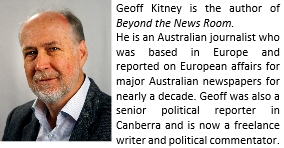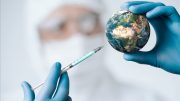Governments that acted decisively earlier in the pandemic are hesitating now, writes Geoff Kitney.
The freedom warriors and the business owners are becoming increasingly assertive and noisy in countries around the world. Covid fighters, in many places, are under siege.
Even as the number of infections continues to rise at rates that dismay health authorities, pressure on governments to give higher priority to saving jobs and livelihoods and, therefore, lower priority to saving lives is increasing.
As Covid spreads, so the Covid wars intensify.
In the first wave of the virus, in most countries, governments put lives ahead of livelihoods.
Those that hesitated, or decided to deny the threat, paid a high price in lost lives but still experienced economic shocks on the same scale as those that responded to the Covid threat robustly.
As the end of Covid-blighted 2020 looms, the feared second wave of Covid is sweeping the world. The northern hemisphere is sliding towards infection rates higher than experienced in the first wave. But resistance to the sort of draconian measures that brought the first wave under control is stronger now. Organised resistance is increasingly apparent in street protests and with pressure on governments.
Governments that acted decisively earlier in the pandemic are hesitating now.
Fear among health authorities of what might happen in the northern winter is growing with every new day’s higher total of infections.
But there is experience to guide the decisions of health policy advisers and government in the coming months. And to show how the politics of the second wave of the virus evolves, depending on how governments respond to it.
Both Australia and New Zealand adopted the same approach to dealing with Covid: they acted early and decisively to fight the virus.
The southern hemisphere has just been through its first Covid winter.
Although this experience varied from country to country, mostly depending on the sophistication of their health systems and their capacity to mobilise resources to deal with the virus, the experience of the most developed countries was that Covid suppression measures resulted in slower spread of the disease and fewer infections than were feared.
Take Australia and New Zealand.
Both have come out of their winter seasons with infection and death rates near the top of the global rankings for the best outcomes. New Zealand has had a death rate of just 5 per one million of the population. Australia has had 35 per million.
This compared to the US with 679 per million, the UK with 643 per million and even Germany, the outstanding performer in Europe, with 118 per million population.
Interestingly, both Australia and New Zealand have had the added good news that winter influenza infections have been at record lows. New Zealand had virtually zero infections. Australia, which recorded 131,000 flu cases and 950 deaths in 2019, recorded just 315 flu cases and 40 deaths in the recent winter.
Both Australia and New Zealand adopted the same approach to dealing with Covid: they acted early and decisively to fight the virus. Of course, they had the advantage that they are island nations with the ability to close their borders quickly and easily, which they did. But they also acted quickly to restrict movements of their own populations through strong lock-downs, backed by robust testing and tracing. In Australia, national and state leaders agreed to form a national cabinet which co-ordinated anti-Covid measures. State Governments closed their state borders with other states.
Between late March and mid-April, the rate of increase in infections nation-wide in Australia slowed from daily increases of up to 25 per cent to just a handful. New Zealand went from a handful to zero. Governments began easing lockdowns. There was talk of a travel “bubble” being opened between Australia and New Zealand.
Australians and New Zealanders celebrated their anti-Covid successes. Approval ratings for national and state leaders soared as high as 90 per cent. The only Covid cases in both countries were people who had arrived from abroad – mostly repatriated citizens allowed to re-enter – and were in quarantine in hotels designated to keep people in detention for two weeks after arrival.
Economies began opening. Children returned to schools. Some states re-opened their borders – although some preferred to wait to see if there was a winter Covid-comeback.
In late June, a cluster of new infections was discovered in a block of public housing apartments in metropolitan Melbourne.
It quickly became apparent that a breach of quarantine at a Melbourne hotel had resulted in a Covid carrier taking the virus back into the community. Within days, the virus was again running rampant. On July 7, the Victorian state government announced the re-imposition of strict lockdowns for the city.
It has taken three months to suppress the virus for a second time – after nearly 20,000 new infections and more than 800 deaths. Melbourne’s winter – relatively colder than other state capitals – undoubtedly helped the rapid spread of the virus.
In the past few days – for the first time since the virus re-emerged – Victoria recorded its first day without a new infection.
Murdoch’s flagship national newspaper, The Australian, carried the headline “Rage against the regime: end lockdown ‘torture’”.
Over the months of the second wave, there was a change in the politics surrounding the virus.
When the Victorian government announced in early July it would return the state to lockdown, there were rumblings of discontent from business owners and conservative politicians, rumblings which were given voice in Rupert Murdoch’s News Limited media outlets. For the first time, public protests began, associated with adherents to the US far-right QAnon conspiracy theorists. Initially political leaders backed the Victorian moves, asserting that “we are all in this together”.
But the Victorian outbreak proved stubbornly hard to suppress. A highly centralised medical system, compared to other states in Australia, struggled to deploy a state-wide test and tracing system. As the Victorian government fought to manage the second wave, and the period of lockdown extended, business organisations began to complain that the economic cost of the lockdown was becoming too great. Murdoch media gave critics a platform. Divisions in the community opened and deepened.
As Victoria, a few days ago, passed the milestone of zero new infections, the political noise reached a crescendo. The previously supportive conservative Federal Government turned on the left-leaning Victorian Labor government, accusing it of imposing draconian lockdown laws which were causing businesses to close and jobs to be lost. It accused the state of “devastating” the state’s economy. Murdoch’s flagship national newspaper, The Australian, carried the headline “Rage against the regime: end lockdown ‘torture’”.
Even some experts without a political axe to grind criticised the Victoria government, arguing that the protracted and deep lockdown was out of proportion to the threat posed by the virus to Victorians. Heavy job losses resulting from the severe lockdown and a sharp increase in mental health issues were seen as a price too high to pay. The Victorian government came under intense pressure to loosen the lockdown and accept the higher level of infections that could be the price of doing this.
The Victorian Premier, Daniel Andrews, refused to budge, saying the strong advice from state health experts was that it was still unsafe to do so.
“We haven’t come this far to allow all the hard work to be undone,” he said. Andrews argued that the best policies for the economy are those which give highest priority to suppressing the virus.
In the public conversation, citizens say that they are thankful that Australia’s political leaders did not follow the examples of US President Donald Trump or UK Prime Minister Boris Johnson.
Despite the ever-more intense criticism of his government’s handling of the Covid fight, opinion polls have consistently shown a majority of the public support his stand.
Attempts to encourage mass demonstrations against Andrews’ policies have produced limited responses.
Across Australia and New Zealand tough Covid-fighting policies have retained the public’s confidence. In the public conversation, citizens say that they are thankful that Australia’s political leaders did not follow the examples of US President Donald Trump or UK Prime Minister Boris Johnson.
As the southern hemisphere summer approaches, the prospect of relative freedom from Covid infections holds the prospect of relatively normal life. That has to be good news for businesses and for the economy.
And there is strong evidence that the silent majority approves of the way their leaders have handled the coronavirus crisis.
New Zealand’s Labour government, led by Jacinda Ardern, has just won an historic landslide victory. In Australia, the first government to face an electoral test since Covid – the left-leaning Labor government in the Australian Capital Territory – has been returned with an increased majority. The conservative national government, which acted early to co-ordinate national efforts to impose restrictions to stop the spread of the virus, enjoys healthy levels of public support.
Leaders like Donald Trump and Boris Johnson might ultimately regret taking a more reckless path.
Headline image credit: oleschwander/Shutterstock.com






